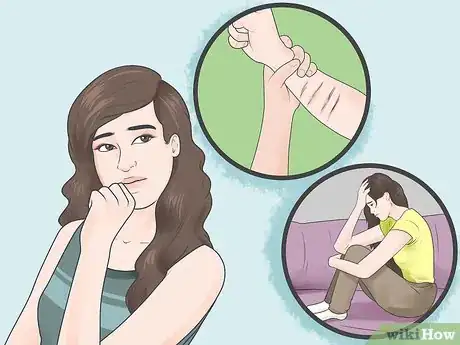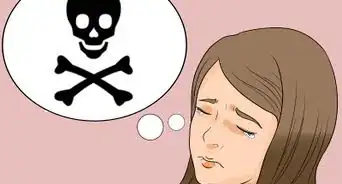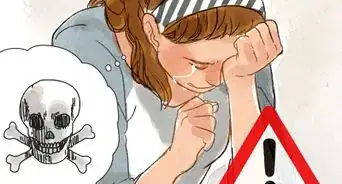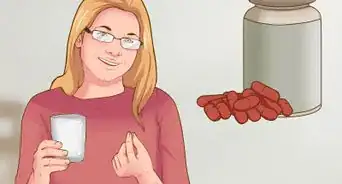This article was co-authored by Trudi Griffin, LPC, MS. Trudi Griffin is a Licensed Professional Counselor in Wisconsin specializing in Addictions and Mental Health. She provides therapy to people who struggle with addictions, mental health, and trauma in community health settings and private practice. She received her MS in Clinical Mental Health Counseling from Marquette University in 2011.
There are 14 references cited in this article, which can be found at the bottom of the page.
wikiHow marks an article as reader-approved once it receives enough positive feedback. In this case, 81% of readers who voted found the article helpful, earning it our reader-approved status.
This article has been viewed 383,350 times.
Bipolar disorder is a mood disorder affecting somewhere between one and 4.3 percent of the US population.[1] It commonly alternates in periods of elevated mood (known as mania) and depression. Bipolar disorder sometimes has an early onset, with research indicating that 1.8% of children and adolescents merit a bipolar diagnosis.[2] Typically though, the disorder is diagnosed around the late twenties or early thirties.[3] This article will help you determine whether you, or someone you care about, might have bipolar disorder.
Steps
Identifying the Symptoms
-
1Recognize the signs of mania. During a manic period, feelings of euphoria, creativity, and heightened awareness are common.[4] Manic periods may last a few hours or stretch on for days or weeks.[5] The Mayo Clinic describes the following signs of mania:[6]
- Having a feeling of being "high," - so high, in some cases, that one feels invincible. This is often accompanied by the feeling that one has special powers or is godlike.
- Dealing with racing thoughts. Thoughts may jump from subject to subject so quickly that it's difficult to keep up or concentrate on one thing.
- Talking so quickly that others can't make sense of what one is saying, and feeling jumpy and restless.
- Staying up all night or sleeping for only a few hours at a time, but never feeling tired the next day.
- Exhibiting reckless behavior. During a manic episode, a person might sleep with several people and not use protection. They may gamble large amounts of money or make risky business investments. An individual might also spend money on large, expensive items, quit a job, and so on.
- Exhibiting extreme irritability and impatience with others. This can escalate into starting arguments and picking fights with people who don't go along with one's ideas.
- In rare cases, delusions, hallucinations, and visions can occur (e.g. believing to hear the voice of God or an angel).
-
2Know the symptoms of bipolar depression. For those with bipolar disorder, the periods of depression are longer and more frequent than periods of mania. Watch for these symptoms:[7]
- An inability to experience pleasure, joy, or even happiness.
- Feelings of hopelessness and inadequacy. Feelings of worthlessness and guilt are also common.
- Sleeping more than normal and feeling tired and sluggish all the time.
- Gaining weight and having changes in appetite.
- Experiencing thoughts of death and suicide.
Did You Know? Bipolar depression often resembles Major Depressive Disorder (MDD); however, medication used to treat MDD is often not effective for treating bipolar depression, and is often accompanied by irritability and mood swings that aren't exhibited by those with MDD.[8] A qualified professional can differentiate between the two disorders.[9]
Advertisement -
3Understand the signs of a hypomanic episode. A hypomanic episode is an abnormally and persistently elevated mood that lasts for four days. It can also include irritability and other symptoms.[10] Hypomania is different from a manic episode in that it is usually less severe. Watch out for:[11]
- Feelings of elation
- Irritability
- Inflated self-esteem or grandiosity
- Decreased need for sleep
- Pressured speech (speech that is rapid and intense)
- Flight of ideas (when one's brain seems to move rapidly from one idea to another)
- Distractibility
- Psychomotor agitation, such as bouncing your leg or tapping your fingers, or an inability to sit still
- Unlike mania, hypomania typically does not result in hospitalization. While someone experiencing hypomania might feel elated, have an increased appetite or sex drive, and may have intense interactions with others, they would likely still be able to go to work and manage ordinary tasks without many, if any, negative consequences. Delusions and hallucinations are also not present in hypomania.[12]
-
4Understand mixed features. In some cases, people experience mania and depression at the same time. These individuals experience depression and irritability, racing thoughts, anxiety, and insomnia simultaneously.
- Mania and hypomania can qualify as having mixed features if there are also three or more symptoms of depression.
- For example, imagine someone is engaging in risky behaviors. They are also experiencing insomnia, hyperactivity, and racing thoughts. This satisfies the full criteria for mania. If this person also experiences at least three symptoms of depression, this is a manic episode with mixed features. Example might be feelings of worthlessness, loss of interest in hobbies or activities, and recurrent thoughts of death.[13]
Understanding Different Forms of Bipolar Disorder
-
1Know the characteristics of bipolar I disorder. This form of bipolar disorder is the most commonly known manic-depressive form of the illness. A person classified as bipolar I must experience at least one manic episode or mixed episode. People with bipolar I disorder may also experience a depressive episode.[14]
- People with bipolar I are the most likely to experience highs that lead to risky behavior.
- This form of the illness is often disruptive to one's work life and relationships.
- Those affected by Bipolar I are more likely to attempt suicide, with a completed suicide rate of 10-15%.[15]
- People suffering from bipolar I are also at a high risk of having or developing a substance abuse problem.[16]
- There is also a connection between bipolar I and hyperthyroidism. This makes it even more important to see a doctor.[17]
-
2Understand the symptoms of bipolar II disorder. This variation involves less intense manic episodes and full-blown depressive episodes. The person may sometimes experience a muted version of hypomania, but the underlying state is usually depression.[18]
- People with bipolar II disorder are often misdiagnosed as having depression. To tell the difference, one must look for the distinguishing characteristics of bipolar depression.
- Bipolar depression is different from MDD because it is often paired with manic symptoms. Sometimes there is overlap between the two. It takes a qualified professional to distinguish between these conditions.[19]
- For people with bipolar II, mania may manifest as anxiety, irritability, or racing thoughts. Bursts of creativity and activity are less common.
- Like bipolar I, there is a high risk for suicide, hyperthyroidism, and substance abuse in bipolar II.[20]
- Bipolar II tends to be more common in women than men.[21]
-
3Look for the signs of cyclothymia. This is a milder form of bipolar disorder that involves mood swings with less severe instances of mania and depression. The mood swings tend to operate on a cycle, going back and forth between depression and mania. According to the Diagnostic and Statistical Manual of Mental Disorders (DSM):[22]
- Cyclothymia begins early in life and its onset is usually in adolescence and early adulthood.
- Cyclothymia is equally common in men and women.
- As with bipolar I and II, there is an increased risk of substance abuse for those affected by cyclothymia.
- Sleep disorders are also commonly found alongside cyclothymia.
Know How to Spot Bipolar Disorder
-
1Look for seasonal changes in mood. It's common for people with bipolar disorder to experience a shift as the seasons change. In some cases, a manic or depressive episode will last an entire season. In other cases, the change in season prompts the beginning of a cycle that includes both mania and depression.
- Manic episodes are more common in the summertime. Depressive episodes are more common in the fall, winter and spring. This is not a hard and fast rule, however; some people experience depression in the summer and mania in the winter.
-
2Understand that having bipolar disorder doesn't always impair functionality. Some people with bipolar disorder have trouble at work and in school. In other cases, the person may seem to be doing just fine in these areas.
- Those with bipolar II and cyclothymia can often function at work and school. Those with bipolar I tend to have a harder time in these areas.[23]
-
3Be aware of substance abuse issues. Up to 50 percent of people who suffer from bipolar disorder struggle with substance abuse. They use alcohol or other tranquilizers to stop racing thoughts during manic episodes. They may also use drugs to try to achieve a high when they're in a depressive episode.[24]
- Substances like alcohol have their own effects on mood and behavior. They can be difficult to distinguish bipolar disorder.
- People who abuse drugs and alcohol are at greater risk of suicide. This is because substance abuse can increase the severity of both mania and depression.
- Substance abuse may also instigate a cycle of manic depression.
-
4Notice breaks from reality. People with bipolar disorder are often out of touch with reality. This occurs both during periods of extreme mania and periods of severe depression.
- This can manifest as either a dangerously inflated ego or a sense of guilt that is not in proportion to real events. In some cases, psychosis and hallucinations occur.
- Breaks from reality happen most frequently in bipolar I during manic and mixed episodes. They occur less often in bipolar II and almost never in cyclothymia.[25]
-
5Talk with your doctor. Because bipolar disorder is a very serious disorder, you need to your doctor and tell them about your symptoms. They may hand your case over to a psychiatrist. Alternatively, you may also see a clinical psychologist or a therapist for diagnosis, but only psychiatrists can prescribe medicine.
- Medications used to treat bipolar disorder include mood stabilizers, antidepressants, antipsychotics, and anti-anxiety drugs. These medications work by blocking and/or regulating certain chemicals in the brain. They regulate dopamine, serotonin, and acetylcholine.[26]
- Mood stabilizers work to regulate a person's mood. They prevent the extreme highs and lows of bipolar disorder. Among these are drugs such as Lithium, Depakote, Neurontin, Lamictal, and Topamax.
- Antipsychotic medications help reduce psychotic symptoms like hallucinations or delusions during mania. They include Zyprexa, Risperdal, Abilify and Saphris.[27]
- Antidepressant medications used to treat bipolar depression include Lexapro, Zoloft, Prozac, and others. Finally, to manage symptoms of anxiety, a psychiatrist might prescribe Xanax, Klonopin, or Lorazepam.[28]
- Medications should always be prescribed by a qualified psychiatrist or physician. They should be taken as directed to avoid health complications.
- If you're concerned that you or a loved one has bipolar disorder, reach out to a therapist or psychiatrist for diagnosis.
- If you or a loved one is having suicidal thoughts, immediately contact a trusted loved one or friend. If you're in the United States, you can also call or text 988 for advice.[29]
Expert Q&A
-
QuestionCan bipolar meds make you worse?
 Padam Bhatia, MDDr. Padam Bhatia is a board certified Psychiatrist who runs Elevate Psychiatry, based in Miami, Florida. He specializes in treating patients with a combination of traditional medicine and evidence-based holistic therapies. He also specializes in electroconvulsive therapy (ECT), Transcranial Magnetic Stimulation (TMS), compassionate use, and complementary and alternative medicine (CAM). Dr. Bhatia is a diplomat of the American Board of Psychiatry and Neurology and a Fellow of the American Psychiatric Association (FAPA). He received an MD from Sidney Kimmel Medical College and has served as the chief resident in adult psychiatry at Zucker Hillside Hospital in New York.
Padam Bhatia, MDDr. Padam Bhatia is a board certified Psychiatrist who runs Elevate Psychiatry, based in Miami, Florida. He specializes in treating patients with a combination of traditional medicine and evidence-based holistic therapies. He also specializes in electroconvulsive therapy (ECT), Transcranial Magnetic Stimulation (TMS), compassionate use, and complementary and alternative medicine (CAM). Dr. Bhatia is a diplomat of the American Board of Psychiatry and Neurology and a Fellow of the American Psychiatric Association (FAPA). He received an MD from Sidney Kimmel Medical College and has served as the chief resident in adult psychiatry at Zucker Hillside Hospital in New York.
Board Certified Psychiatrist If you feel like bipolar medication is making your symptoms worse, talk to your psychiatrist about it. People occasionally respond differently to different medications, so just work with your treatment team to make adjustments to your medication.
If you feel like bipolar medication is making your symptoms worse, talk to your psychiatrist about it. People occasionally respond differently to different medications, so just work with your treatment team to make adjustments to your medication. -
QuestionHow do you find out if you're bipolar?
 George Sachs, PsyDGeorge Sachs is a Licensed Psychologist and the Owner of Sachs Center based in New York, New York. With over ten years of experience, Dr. Sachs specializes in treating ADD/ADHD and Autism Spectrum Disorders in children, teens, and adults. He holds a BS in Psychology from Emory University. Dr. Sachs earned his Doctorate of Psychology (PsyD) from the Illinois School of Professional Psychology, Chicago. He completed his clinical training in Chicago at Cook County Hospital, Mt. Sinai Hospital, and the Child Study Center. Dr. Sachs completed his internship and postdoctoral work at the Children’s Institute in Los Angeles, where he supervised and trained therapists in Trauma-Focused Cognitive Behavioral Therapy (TFCBT). He has been trained as a Gestalt Therapist and certified by the Gestalt Associates Training Program of Los Angeles. Dr. Sachs is the author of The Adult ADD Solution, Helping the Traumatized Child, and Helping Your Husband with Adult ADD. He has appeared on the Huffington Post, NBC Nightly News, CBS, and WPIX discussing his holistic approach to ADD/ADHD treatment.
George Sachs, PsyDGeorge Sachs is a Licensed Psychologist and the Owner of Sachs Center based in New York, New York. With over ten years of experience, Dr. Sachs specializes in treating ADD/ADHD and Autism Spectrum Disorders in children, teens, and adults. He holds a BS in Psychology from Emory University. Dr. Sachs earned his Doctorate of Psychology (PsyD) from the Illinois School of Professional Psychology, Chicago. He completed his clinical training in Chicago at Cook County Hospital, Mt. Sinai Hospital, and the Child Study Center. Dr. Sachs completed his internship and postdoctoral work at the Children’s Institute in Los Angeles, where he supervised and trained therapists in Trauma-Focused Cognitive Behavioral Therapy (TFCBT). He has been trained as a Gestalt Therapist and certified by the Gestalt Associates Training Program of Los Angeles. Dr. Sachs is the author of The Adult ADD Solution, Helping the Traumatized Child, and Helping Your Husband with Adult ADD. He has appeared on the Huffington Post, NBC Nightly News, CBS, and WPIX discussing his holistic approach to ADD/ADHD treatment.
Licensed Psychologist The only way to determine this is by getting an evaluation from a trained medical professional. You won't be able to come to a diagnosis on your own.
The only way to determine this is by getting an evaluation from a trained medical professional. You won't be able to come to a diagnosis on your own. -
QuestionWhat's more common, ADHD or bipolar disorder?
 George Sachs, PsyDGeorge Sachs is a Licensed Psychologist and the Owner of Sachs Center based in New York, New York. With over ten years of experience, Dr. Sachs specializes in treating ADD/ADHD and Autism Spectrum Disorders in children, teens, and adults. He holds a BS in Psychology from Emory University. Dr. Sachs earned his Doctorate of Psychology (PsyD) from the Illinois School of Professional Psychology, Chicago. He completed his clinical training in Chicago at Cook County Hospital, Mt. Sinai Hospital, and the Child Study Center. Dr. Sachs completed his internship and postdoctoral work at the Children’s Institute in Los Angeles, where he supervised and trained therapists in Trauma-Focused Cognitive Behavioral Therapy (TFCBT). He has been trained as a Gestalt Therapist and certified by the Gestalt Associates Training Program of Los Angeles. Dr. Sachs is the author of The Adult ADD Solution, Helping the Traumatized Child, and Helping Your Husband with Adult ADD. He has appeared on the Huffington Post, NBC Nightly News, CBS, and WPIX discussing his holistic approach to ADD/ADHD treatment.
George Sachs, PsyDGeorge Sachs is a Licensed Psychologist and the Owner of Sachs Center based in New York, New York. With over ten years of experience, Dr. Sachs specializes in treating ADD/ADHD and Autism Spectrum Disorders in children, teens, and adults. He holds a BS in Psychology from Emory University. Dr. Sachs earned his Doctorate of Psychology (PsyD) from the Illinois School of Professional Psychology, Chicago. He completed his clinical training in Chicago at Cook County Hospital, Mt. Sinai Hospital, and the Child Study Center. Dr. Sachs completed his internship and postdoctoral work at the Children’s Institute in Los Angeles, where he supervised and trained therapists in Trauma-Focused Cognitive Behavioral Therapy (TFCBT). He has been trained as a Gestalt Therapist and certified by the Gestalt Associates Training Program of Los Angeles. Dr. Sachs is the author of The Adult ADD Solution, Helping the Traumatized Child, and Helping Your Husband with Adult ADD. He has appeared on the Huffington Post, NBC Nightly News, CBS, and WPIX discussing his holistic approach to ADD/ADHD treatment.
Licensed Psychologist Bipolar disorder is relatively rare, while ADHD is fairly common. This is especially true when it comes to children; children are much less likely to be diagnosed with bipolar disorder.
Bipolar disorder is relatively rare, while ADHD is fairly common. This is especially true when it comes to children; children are much less likely to be diagnosed with bipolar disorder.
Warnings
- This article is only intended to help you look for possible symptoms of bipolar disorder. It is not meant to diagnose or treat. Please see a doctor if you think you or a loved one may have bipolar disorder.⧼thumbs_response⧽
References
- ↑ http://www.webmd.com/bipolar-disorder/news/20050617/bipolar-disorder-more-common-than-expected
- ↑ Radu, D.A., Chirita, R., Untu, I., Sacuiu, I., Lupu, V.V., Ciubara, A., & Burlea, L.C. (2014). Bipolar disorder in children: diagnostical challenge. Revista Romana de Pediatrie, 58(2).
- ↑ Radu, D.A., Chirita, R., Untu, I., Sacuiu, I., Lupu, V.V., Ciubara, A., & Burlea, L.C. (2014). Bipolar disorder in children: diagnostical challenge. Revista Romana de Pediatrie, 58(2).
- ↑ http://www.webmd.com/bipolar-disorder/guide/bipolar-disorder-warning-signs
- ↑ http://www.nimh.nih.gov/health/topics/bipolar-disorder/index.shtml#part_145404
- ↑ http://www.mayoclinic.org/diseases-conditions/bipolar-disorder/basics/symptoms/con-20027544
- ↑ http://www.mayoclinic.org/diseases-conditions/bipolar-disorder/basics/symptoms/con-20027544
- ↑ http://www.webmd.com/bipolar-disorder/guide/bipolar-disorder-warning-signs
- ↑ American Psychiatric Association. (2013). Diagnostic and Statistical Manual of Mental Disorders: DSM-5. Washington DC: American Psychiatric Association.
- ↑ American Psychiatric Association. (2000). Diagnostic and Statistical Manual of Mental Disorders (4th ed., text rev.). Washington, DC: Author.
- ↑ American Psychiatric Association. (2013). Diagnostic and Statistical Manual of Mental Disorders: DSM-5. Washington DC: American Psychiatric Association.
- ↑ American Psychiatric Association. (2000). Diagnostic and Statistical Manual of Mental Disorders (4th ed., text rev.). Washington, DC: Author.
- ↑ http://psychcentral.com/disorders/bipolar-disorder-with-mixed-features/
- ↑ https://www.helpguide.org/articles/bipolar-disorder/bipolar-disorder-treatment.htm
- ↑ American Psychiatric Association. (2000). Diagnostic and Statistical Manual of Mental Disorders (4th ed., text rev.). Washington, DC: Author.
- ↑ American Psychiatric Association. (2000). Diagnostic and Statistical Manual of Mental Disorders (4th ed., text rev.). Washington, DC: Author.
- ↑ American Psychiatric Association. (2000). Diagnostic and Statistical Manual of Mental Disorders (4th ed., text rev.). Washington, DC: Author.
- ↑ http://www.webmd.com/bipolar-disorder/guide/bipolar-2-disorder
- ↑ American Psychiatric Association. (2013). Diagnostic and Statistical Manual of Mental Disorders: DSM-5. Washington DC: American Psychiatric Association.
- ↑ American Psychiatric Association. (2000). Diagnostic and Statistical Manual of Mental Disorders (4th ed., text rev.). Washington, DC: Author.
- ↑ American Psychiatric Association. (2000). Diagnostic and Statistical Manual of Mental Disorders (4th ed., text rev.). Washington, DC: Author.
- ↑ American Psychiatric Association. (2013). Diagnostic and Statistical Manual of Mental Disorders: DSM-5. Washington DC: American Psychiatric Association.
- ↑ American Psychiatric Association. (2000). Diagnostic and Statistical Manual of Mental Disorders (4th ed., text rev.). Washington, DC: Author.
- ↑ http://www.mayoclinic.com/health/bipolar-disorder/DS00356/DSECTION=symptoms
- ↑ American Psychiatric Association. (2000). Diagnostic and Statistical Manual of Mental Disorders (4th ed., text rev.). Washington, DC: Author.
- ↑ Young, L.T. (2004). What exactly is a mood stabilizer? Journal of Psychiatry and Neuroscience, 29(2), pp. 87-88.
- ↑ http://www.mayoclinic.org/diseases-conditions/bipolar-disorder/basics/treatment/con-20027544
- ↑ http://www.mayoclinic.org/diseases-conditions/bipolar-disorder/basics/treatment/con-20027544
- ↑ https://988lifeline.org/
About This Article
If you think you have bipolar disorder, check to see if you exhibit common symptoms, like having moods that alternate between extreme high periods, also known as mania, and depression. You may also experience manic episodes, which include feelings like euphoria, racing thoughts, and engaging in reckless behavior, while depressive periods involve feelings of hopelessness and guilt. If you think you may be bipolar, make an appointment with a mental health specialist to start a treatment plan, which may include therapy and/or medication. For more advice from our Mental Health reviewer, including how to recognize and diagnose the different types of bipolar disorder, read on!


















-Episode-Step-22.webp)

























































Medical Disclaimer
The content of this article is not intended to be a substitute for professional medical advice, examination, diagnosis, or treatment. You should always contact your doctor or other qualified healthcare professional before starting, changing, or stopping any kind of health treatment.
Read More...